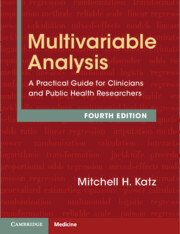Book contents
- Multivariable Analysis
- Multivariable Analysis
- Copyright page
- Contents
- Preface
- 1 Introduction
- 2 Common Uses of Multivariable Models
- 3 Outcome Variables in Multivariable Analysis
- 4 Independent Variables in Multivariable Analysis
- 5 Relationship of Independent Variables to One Another
- 6 Setting Up a Multivariable Analysis
- 7 Performing the Analysis
- 8 Interpreting the Results
- 9 Delving Deeper: Checking the Underlying Assumptions of the Analysis
- 10 Propensity Scores
- 11 Correlated Observations
- 12 Sensitivity Analysis
- 13 Validation of Models
- 14 Special Topics
- 15 Publishing Your Study
- 16 Summary: Steps for Constructing a Multivariable Model
- Index
5 - Relationship of Independent Variables to One Another
Published online by Cambridge University Press: 09 October 2025
- Multivariable Analysis
- Multivariable Analysis
- Copyright page
- Contents
- Preface
- 1 Introduction
- 2 Common Uses of Multivariable Models
- 3 Outcome Variables in Multivariable Analysis
- 4 Independent Variables in Multivariable Analysis
- 5 Relationship of Independent Variables to One Another
- 6 Setting Up a Multivariable Analysis
- 7 Performing the Analysis
- 8 Interpreting the Results
- 9 Delving Deeper: Checking the Underlying Assumptions of the Analysis
- 10 Propensity Scores
- 11 Correlated Observations
- 12 Sensitivity Analysis
- 13 Validation of Models
- 14 Special Topics
- 15 Publishing Your Study
- 16 Summary: Steps for Constructing a Multivariable Model
- Index
Summary
The strength of multivariable analysis is its ability to determine how multiple independent variables, which are related to one another, are related to an outcome. However, if two variables are so closely correlated that if you know the value for one variable you know the value of the other, multivariable analysis cannot separately assess the impact of these two variables on outcome. This problem is called multicollinearity.
To assess whether there is multicollinearity, investigators should first run a correlation matrix. However, the matrix only tells you the relationship between any two independent variables. Harder to detect is whether a combination of variables accounts for another variable’s value. Two related measure of muticollinearity are tolerance and the reciprocal of tolerance: the variation inflation factor. If you have variables that are highly related, you can omit one or more of the variables, use an “and/or” clause or create a scale.
Keywords
Information
- Type
- Chapter
- Information
- Multivariable AnalysisA Practical Guide for Clinicians and Public Health Researchers, pp. 93 - 97Publisher: Cambridge University PressPrint publication year: 2025
Accessibility standard: Inaccessible, or known limited accessibility
Why this information is here
This section outlines the accessibility features of this content - including support for screen readers, full keyboard navigation and high-contrast display options. This may not be relevant for you.Accessibility Information
Content Navigation
Allows you to navigate directly to chapters, sections, or non‐text items through a linked table of contents, reducing the need for extensive scrolling.
Provides an interactive index, letting you go straight to where a term or subject appears in the text without manual searching.
Reading Order & Textual Equivalents
You will encounter all content (including footnotes, captions, etc.) in a clear, sequential flow, making it easier to follow with assistive tools like screen readers.
You get more than just short alt text: you have comprehensive text equivalents, transcripts, captions, or audio descriptions for substantial non‐text content, which is especially helpful for complex visuals or multimedia.
You can access graphs or charts in a text or tabular format, so you are not excluded if you cannot process visual displays.
Visual Accessibility
You will still understand key ideas or prompts without relying solely on colour, which is especially helpful if you have colour vision deficiencies.
You benefit from high‐contrast text, which improves legibility if you have low vision or if you are reading in less‐than‐ideal lighting conditions.
